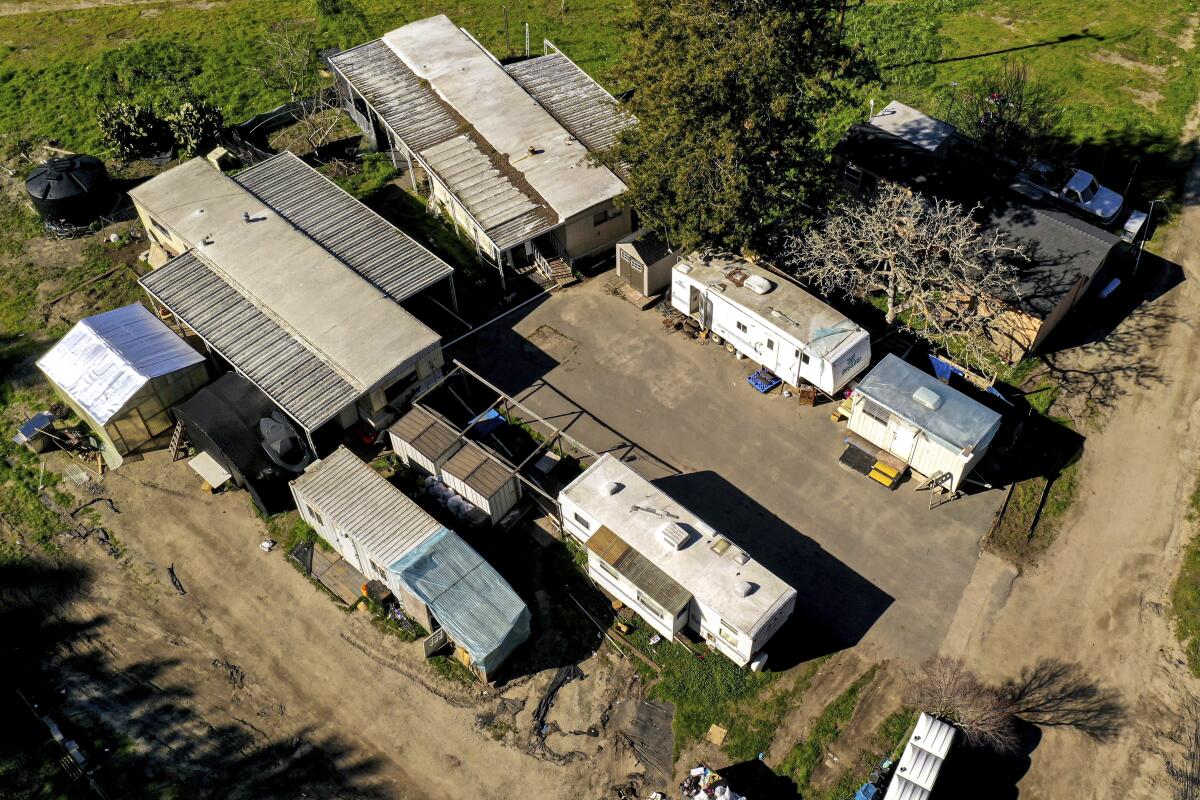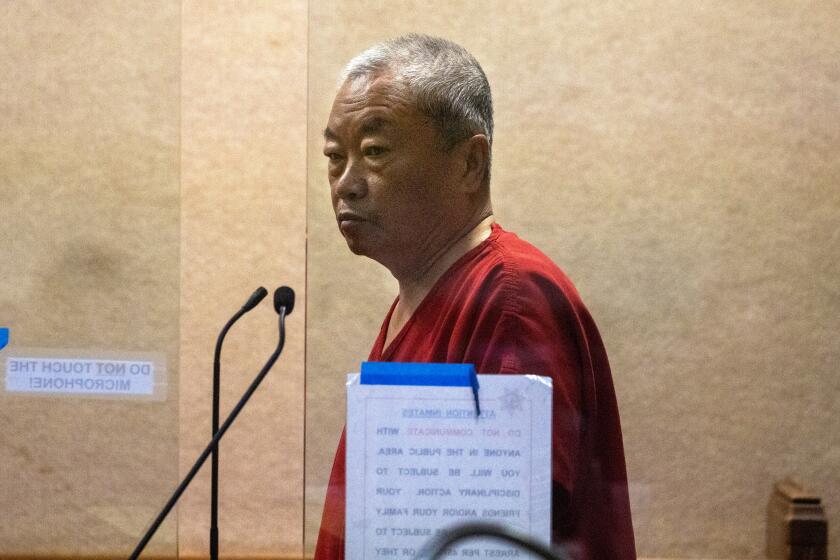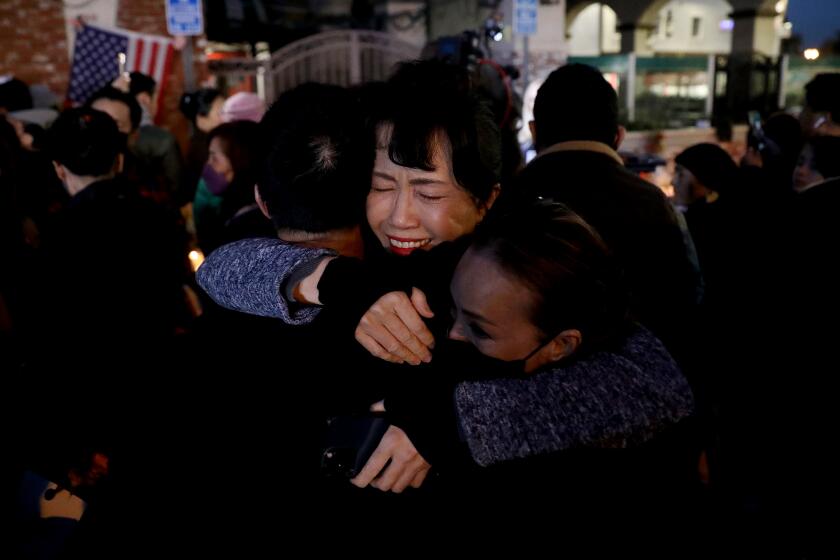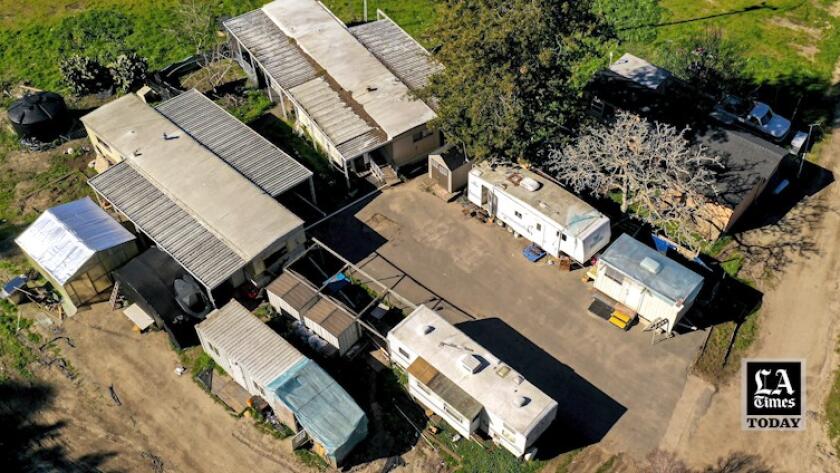‘I want to be heard’: Half Moon Bay farmworkers struggle in ‘deplorable’ conditions

- Share via
HALF MOON BAY, Calif. — It’s not news to Bernardina Medrano and Margarita Martinez that many migrant farmworkers along the San Mateo County coast live in “deplorable” conditions, as Gov. Gavin Newsom and county Supervisor Ray Mueller have described.
Medrano, 43, who pays $850 a month to share a two-bedroom trailer in Pescadero with four other adults and two children, has been here 16 years. Martinez, who lives in a garage, has been here more than 10.
They say finding affordable and safe housing is one of the community’s biggest obstacles and hope the attention focused on the area after Monday’s mass killing of farmworkers in Half Moon Bay will prompt political decision-makers and the public to finally listen.
“To me, that’s the magic word: Listen. I want to be heard,” Martinez said.
To most Bay Area residents, Half Moon Bay and nearby coastal areas, such as Pescadero and San Gregorio, conjure images of breathtaking beaches, epic surf and world-class golf courses. It’s where tech workers and venture capitalists come to unwind.
Chunli Zhao told NBC Bay Area he carried out the two shootings that left seven of his co-workers dead, and claimed that he suffered years of bullying.
But at its core, it’s an agricultural community — one that is increasingly struggling as Silicon Valley tycoons buy up land, remote office workers drive up rents, a legacy farming community is squeezed and undercut by foreign growers that can produce the same crops for a fraction of the price, and climate change wreaks havoc on production.
“It sometimes feels like we are on a precipice,” said Veronica Mazariegos-Anastassiou, an operator of Brisa Ranch, a farm in Pescadero, a few miles south of Half Moon Bay. “Like it’s all about to fall.”
On Friday night, hundreds gathered at Mac Dutra Park in Half Moon Bay for a memorial service for the shooting victims .
Renauto Juares Perez, cousin of Jose Romero Perez, one of those slain, told the crowd in Spanish that he “felt very safe having him next to me.”
He and Servando Martinez, whose brother Marciano was killed, both thanked the people of Half Moon Bay for their support in the days since the shooting.
“In this moment he is with my parents, taking care of each one of them like he took care of us,” Martinez said.
Both received applause, and the hundreds of attendees joined in singing “Amazing Grace.”
On Tuesday, Newsom told reporters that workers at California Terra Garden (formerly Mountain Mushroom Farm), where four were killed in Monday’s shootings, were living in shipping containers and earning $9 an hour, which he described as “simply deplorable.”
Mueller toured the site Thursday and described the workers’ living conditions as “heartbreaking.” He posted photos on Twitter showing a structure with only a corrugated plastic wall to provide shelter, unfinished floors with pieces of plywood strewn about and propane tanks tucked into the “kitchen” corner to fuel a two-burner camping stove.
California’s Division of Occupational Safety and Health and the state labor commissioner’s office are investigating working conditions in the region. Mueller said he’ll be working with San Mateo County to identify other problematic sites.
David Oates, a spokesperson hired by California Terra Garden, declined to comment on the state investigation and said Newsom’s characterization of low pay and poor living conditions for workers doesn’t “reflect the conditions at California Terra Gardens.”
Eucalyptus trees droop over the stretch of Highway 92 that connects California Terra Garden and other farms and nurseries to the town center. Along the narrow, winding road are downed tree limbs and scattered bark, a reminder of recent storms. Behind the farms’ facades, visible from the road, the occasional trailer or mobile home can be seen.
Statistics from a recent survey conducted by local organization Abundant Grace Coastside Worker and interviews with officials suggest that many farmworkers live cramped in unsuitable dwellings.
“Farms need workers, so people come here to work,” Mazariegos-Anastassiou said. “They want to work, but they can’t afford housing. So they find a way to live. There are lots of abandoned greenhouses and buildings. So they move into places that may not have running water or electricity.”
Medrano, whose 15-year-old daughter goes to school in Pescadero, stressed that like everybody else, farmworkers want stability and don’t want to move their families around.
“I would like for us to have a bigger place. I can’t afford it. So we adapt,” she said.
But she can see the tragedy that can come from living in substandard housing.
In October, two farmworkers were found dead in a Pescadero pond. Although the San Mateo County Sheriff’s Office classified it as “accidental drowning,” both Mazariegos-Anastassiou and Rita Mancera, executive director of the Puente, a local aid and advocacy organization, said the men had probably been bathing in the pond, as there are people living without access to running water.
B.J. Burns, president of the San Mateo County Farm Bureau, said he knows there are farms in the region where people are living in unsafe conditions.
“God almighty. That’s not the way agriculture operates,” Burns said. “Trust me when I’m telling you: We don’t and shouldn’t operate that way. These people are part of our family. ... I can’t see how people can treat people like this. I just don’t understand that.”
The farmworkers, farmers and community organizers said the price of land and housing has skyrocketed in recent years, as Silicon Valley billionaires have scooped up real estate along the San Mateo coast.
Real estate agent Leo Campos said lower-level tech workers — millionaires, not billionaires — started migrating to the area during the pandemic since they were able to work remotely. At a recent open house for a $2.77-million listing in Half Moon Bay, he said, 75% of the visitors worked in tech.
“The demographics are changing,” he said, adding that most are buying the properties as second or third homes and typically use them only during the summer.
“It’s driving up prices and pushing people out,” he said.
Exorbitant living costs, in combination with a struggling farming industry, have left workers such as Mancera and Martinez worried about the future.
While Saturday’s mass shooting still weighs heavily on the community, instructors and students say they are ready to get back to dancing.
For decades, this was a thriving farming region where flowers, artichokes, mushrooms and other vegetables were grown. Burns said that 15 to 20 years ago, roughly 2,000 to 3,000 farmworkers were employed in the area. Now, he said, the number is between 700 and 1,000.
“Campbell’s used to have a mushroom farm here,” said Caleb Barron, owner of Pescadero’s Fogline Farm, referring to the soup company. That mushroom farm was sold and closed down in 2004, after its owners decided they were losing too much money. Two hundred jobs were lost.
In 2019, another of the region’s mainstays — Bay City Flower — closed its doors; it couldn’t compete with growers in Arizona and Latin America that operate at a fraction of the cost, Burns said. Two hundred farm jobs were lost.
“It’s cheaper to grow flowers in Latin America, even Arizona — harvest them there, chill them there, and then fly them in refrigerated airplanes to the Bay Area — than it is to grow them here,” said Burns.
He said labor costs and high rents are the farming industry’s biggest burdens.
“Minimum wage is going from $15.50 to $16.50. And most people don’t understand, but we can’t pay minimum wage here. People can’t afford to live here on minimum wage. So we pay more,” he said.
Transportation is also costly. There is no distribution center in the region, meaning farmers have to truck perishable products over the mountains or up the coast to San Francisco. During wildfire and rainy seasons, roads can be closed for days.
In the most recent storms, Highway 92 — which connects Half Moon Bay to Silicon Valley — was closed for several days while workers repaired a sinkhole. Highway 1 experienced closures — both north and south — due to landslides.
Many farmworkers sat idle as fields were flooded, power outages shuttered operations and the road closures prevented movement into and out of the region.
“Lots of people are out of work right now,” said Medrano, who is without a job, though she’s hopeful that when spring comes, there will be work on the farms.
She’s eager to get paid so she can afford rent, food, transportation and her cellphone. During an interview on Thursday, she said she shakes her head when she thinks about how much celebrities earn.
“I think, how can a singer make so much money when a person — a farmworker — works so physically hard to bring food to people’s tables and makes so little,” she said. “I wish people would come and try to do the work we do. I think they would learn a lot.”
Times staff writer Salvador Hernandez contributed to this report.
- Share via
Watch L.A. Times Today at 7 p.m. on Spectrum News 1 on Channel 1 or live stream on the Spectrum News App. Palos Verdes Peninsula and Orange County viewers can watch on Cox Systems on channel 99.
More to Read
Sign up for Essential California
The most important California stories and recommendations in your inbox every morning.
You may occasionally receive promotional content from the Los Angeles Times.
















